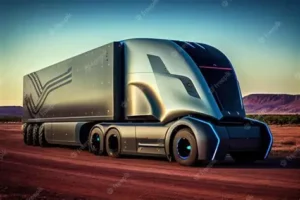A new chapter in U.S. freight transport is unfolding under the stars. Autonomous trucks are now running overnight routes on some of Texas’s busiest highways, thanks to Aurora Innovation, a company pushing the boundaries of self-driving technology.
The company’s trucks, outfitted with cutting-edge sensors and software, are currently hauling goods like dairy and produce between Dallas and Houston, marking a significant expansion of real-world driverless operations beyond daylight hours.
🔦 Technology That Sees in the Dark
Aurora’s system relies on Lidar, which uses laser pulses to map the truck’s environment in 3D—even in complete darkness. According to the company, this allows the vehicle to spot hazards more than 1,000 feet ahead, providing a reaction window of up to 11 seconds, far longer than most human drivers have at night.
This enhanced visibility enables the vehicle to distinguish between objects like a person and road debris—something that becomes more difficult in low-light conditions.
🛣️ Expanding the Autonomous Footprint
While city-based autonomous vehicles—such as Waymo’s self-driving taxis—have operated around the clock for some time, long-haul trucking has been slower to adopt nighttime operations. That’s changing.
Aurora’s trucks currently include a safety driver in the cab as a precaution, but the system has already driven over 20,000 miles without human input on public roads. Elsewhere in the region, Kodiak Robotics is operating fully driverless trucks transporting fracking materials on private roads in West Texas and New Mexico.
🚚 Impact on the Trucking Industry
Carriers like Hirschbach Motor Lines, which runs thousands of trucks nationwide, have begun integrating Aurora’s vehicles into their logistics network. CEO Richard Stocking believes automation could help address industry challenges, from driver shortages to the need for more predictable schedules.
“If autonomous trucks take on the longest routes, human drivers can handle the local jobs—and be home more often,” Stocking explained.
For companies dealing with tight delivery windows and labor constraints, 24/7 autonomous freight could provide new flexibility and efficiency.
⚠️ Not Everyone Is Sold
Some truckers, however, remain cautious. Troy Turnham, who’s been driving for years out of Oklahoma, expressed doubts about how well these vehicles will handle complex situations:
“They might be okay on empty roads, but how will they do in a thunderstorm or in snow? That’s when I worry.”
Aurora’s team acknowledges these concerns and is now working on enabling its system to drive in wet weather, with plans to roll out that capability by the end of 2025.
🚛 A Glimpse Into the Future
The success of autonomous trucks in Texas could reshape the logistics landscape. By running at night, these vehicles can avoid traffic, reduce delivery times, and unlock new economic efficiencies. With safety drivers still present for now, full autonomy remains a work in progress—but the technology is moving forward quickly.
As Aurora continues expanding to longer routes—like Phoenix to Fort Worth, a 16-hour haul that normally requires two human drivers—the question isn’t if driverless trucks will become the norm, but how soon.

